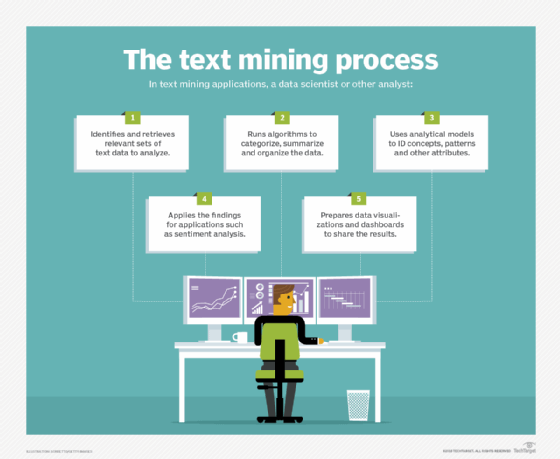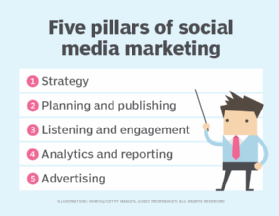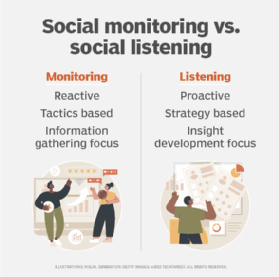social listening (social media listening)
What is social listening?
Social listening, also referred to as social media listening, is the process of identifying and assessing what is being said about a company, individual, product or brand on the internet.
Conversations on the internet produce massive amounts of unstructured data. Because of that, it's important to know what an organization wants to achieve with a social media listening initiative. Depending on the goal, the right tool might be a series of free Google Alerts or an expensive software suite that includes ad hoc analysis and full integration with legacy customer relationship management (CRM) applications.
Both social media and person-to-person information-gathering have value, but social listening is quickly becoming an important customer intelligence tool. Among the many ways to use social media to gain insight are the following:
- monitoring online customer support forums;
- using software tools to gather comments from social outlets, such as Facebook and Twitter; and
- encouraging customers to suggest new product features and vote on their favorites.
Social media monitoring tools can mine text for specific keywords on social networking websites, blogs and in discussion forums and other social media. Monitoring software transposes specific words or phrases in unstructured data into numerical values linked to structured data in a database. That way the data can be analyzed with traditional data mining techniques.

Why is social listening important?
Social listening helps companies understand the conversation surrounding their brand and the products and services they offer. It provides valuable consumer data that companies can use to gauge brand awareness and improve their products and services.
Companies gain the following benefits from social listening:
- Campaign analysis provides feedback on how a particular marketing campaign resonates with audiences on social.
- Competitive analysis reveals insights into how competitors are doing based on conversations on social media.
- Event monitoring enables a company to see how audiences respond in real time to a specific event, such as a virtual conference.
- Industry trends surface when a company listens for discussions mentioning its industry, using social functions like hashtags.

Companies can use the conversational data they gather through social listening to alter their treatment of these things. For example, if the conversation around a certain marketing campaign is negative, a company might change the current campaign to address the problem. It could also use the information to craft better campaigns in the future.
If social conversations about a company's competitors are positive, it might mimic the competitions' behavior. Gathering social intelligence from social media conversations is a good way to gauge authentic audience sentiment and reactions.
Social listening vs. social monitoring
Social monitoring explains what people are saying on social media. Social listening explains why people are saying what they are saying. Monitoring is tactical, whereas listening focuses on long-term strategic decisions.
Examples of each are as follows:
Social monitoring. A restaurant monitors Twitter for mentions of its new product -- a hamburger with cream cheese on the bun. Once detected, the business may respond to the mention but doesn't have to. The main point of monitoring is gathering information. There is not necessarily a strategy attached. The business can see all the different ways its hamburger comes up in conversation online.
Social listening. The same restaurant monitors social media for mention of its new hamburger and aggregates the data to perform a sentiment analysis of what people are saying. The restaurant uses the information collected to develop a broader marketing strategy. Using sentiment analysis, it can determine the following:
- whether people like the hamburger;
- what they like about it;
- what they like to eat with it;
- how long to keep the hamburger on the menu; and
- new ideas for its next featured product.
In the listening example, the business does not engage with every mention of the product. It doesn't try to affect the conversation or change people's feelings about the product. Instead, it aims to read sentiment and gain insights with the goal of developing a strategy to improve sentiment in the future.
Social listening and social monitoring are not mutually exclusive. A social listening strategy takes social monitoring a step further to gain a better understanding of brand-centric conversations on social networks.

How does social listening work?
The goal of social media listening is to monitor relevant conversations on social media platforms, understand the underlying mood or sentiment and respond with a marketing strategy that influences sentiment favorably. The social listening process consists of three main steps:
- Monitoring. This entails monitoring multiple social media channels for mentions of brand names, topics, competitors, keywords and products in social conversations. A business can do this type of brand monitoring manually by checking social media sites daily or more frequently or it can use a tool to automate the process.
- Analysis. This is the step that sets social listening apart from monitoring. Companies analyze information gathered during monitoring to identify what customers like and don't like about a product or service and look for patterns and trends. A variety of customer sentiment analysis tools are available that use automated software to offer companies insight into the emotion behind the text customers write or say.
- Response. Companies may then choose to respond. This may be a small response, such as communicating with a customer online, or a big one, like repositioning the entire brand strategy.
Companies can use the information collected from social listening for other purposes, including the following:
- to identify potential customers and unhappy existing ones;
- to gauge the quality of the customer experience (CX); and
- to collect information to use for return-on-investment monitoring or to A/B test different versions of a campaign to compare how they perform.
Social listening tips
Best practices to perform social listening effectively include the following:
- Understand the audience. Learn which buyer personas are attracted to a brand and its products and services. Understand how to market to the target audience on its platform of choice.
- Determine what to listen for. There will be a wealth of data to draw insights from. It is important to have a clear idea of what your organization wants to learn from the data. This will help businesses ignore noise in the data set.
- Use keywords to find data. Keywords are a good way to filter conversations on social media. They can relate to a company, its brands, products and services, or to a larger industry.
- Use a social listening tool. Tools for collecting unstructured social data can help gather insights from the data they collect.
- Develop a strategy. After analyzing social data, it's important to use the findings to develop a strategy. If a company finds the social conversation is favorable, it should find out what customers like about it. If a business finds customers are unhappy, then it should explore what's wrong and look for ways to change. This might mean changing product descriptions, prices or features. Or it could mean adopting other marketing strategies to better explain their offerings, such as optimizing data-driven content creation.
Social listening tools
The following social listening tools are available:
- Clarabridge is a CX management AI platform.
- HubSpot provides marketing, sales, customer service and CRM software.
- Lately is social AI content and social media software.
- Sprout Social is social media management software.
- Hootsuite is a social media management and marketing dashboard.
These products may function as standalone social listening tools. In some cases, they can be integrated into an enterprise CRM system. As part of a CRM platform, these tools enable an organization to gather CX data from many channels and organize it in one place for analysis. Sources from which tools gather information include Facebook, Twitter, TripAdvisor and Booking.com.
With some social tools, users can create custom listening templates that track specific keywords and topics. They may also provide business intelligence dashboards. Another common feature identifies and tracks influencers in relevant industries. Users can track key performance indicators and metrics about their key influencers, such as the number of engagements with their posts and the number of times they post about a certain topic.
How to get started with social media listening
Before buying a social listening tool, businesses should know what they want to accomplish through social listening. There are also plenty of free social listening alternatives available if a paid enterprise software offering doesn't seem necessary.
Examples of free tools include TweetDeck and Google Alerts. Like the paid options, these tools enable users to monitor social conversations for simple topics and keywords and schedule automatic posts. These free tools do have drawbacks, such as the following:
- They capture a lot of noise.
- They have limited or no analysis features.
- They make data visualization
Companies can also use sentiment analysis tools and application program interfaces to help with social listening efforts.
Free tools like Tweet Deck and Google Alerts typically only work with one social platform. Organizations wanting a tool to develop an omnichannel marketing strategy should consider paid tools with more data visualization and analytics features. Some providers have social listening offerings for specific industries.
Gathering social data is an important part of creating a customer experience strategy. Learn other ways companies can create a great CX strategy.





